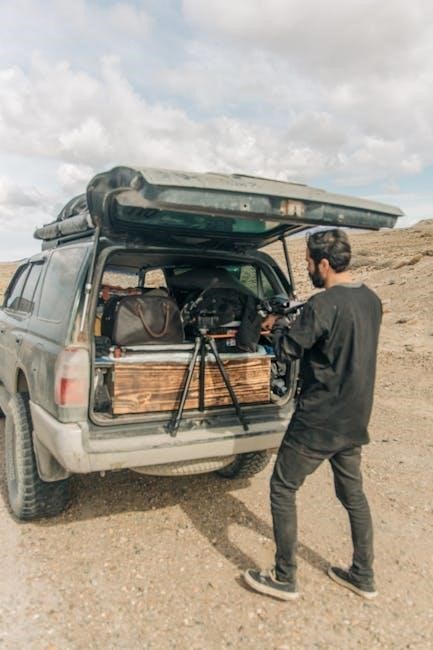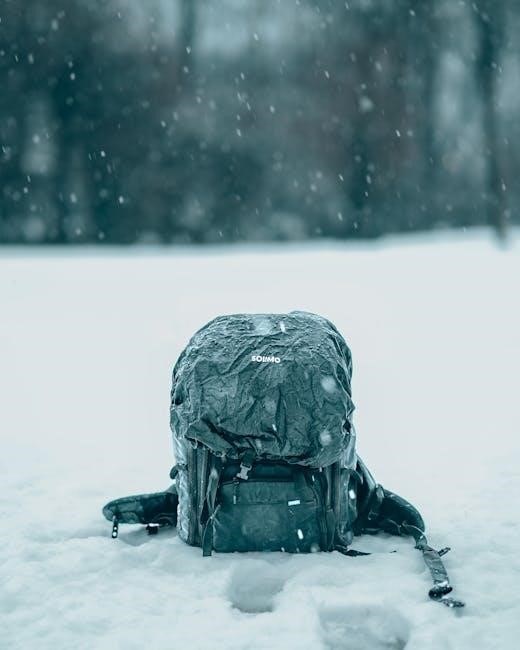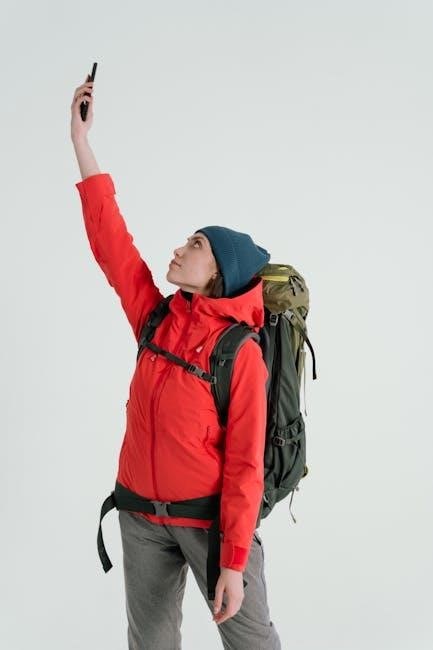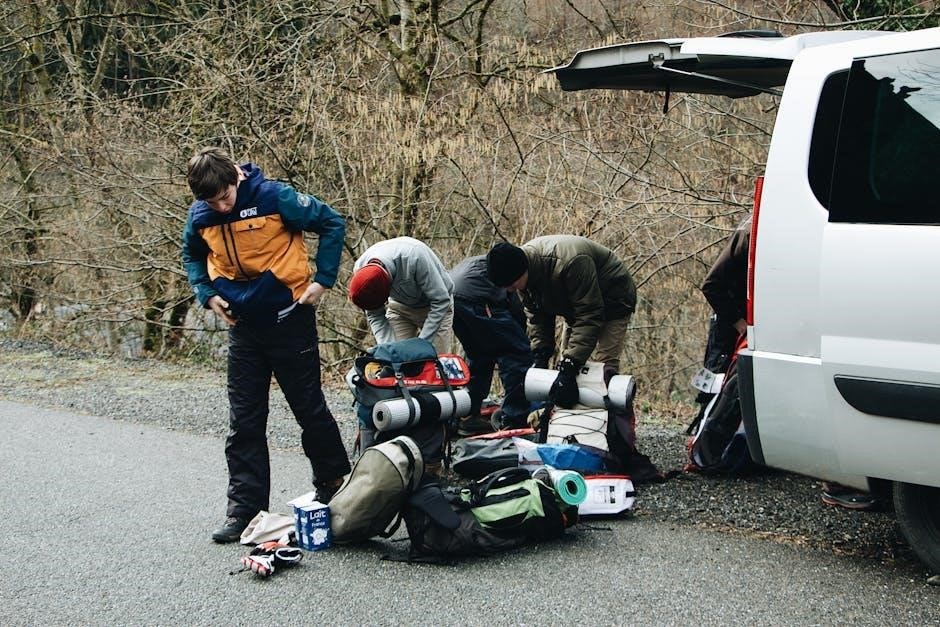1.1. Understanding the Basics of Backpacking
Backpacking is a combination of hiking and camping, emphasizing lightweight gear and self-reliance. It’s about exploring nature while carrying everything needed for survival, fostering freedom and simplicity.
Backpacking is a blend of hiking and camping, emphasizing self-reliance and lightweight gear. It involves carrying all essentials in a backpack, allowing exploration of remote areas. Key elements include planning, minimizing weight, and selecting multi-use items. Understanding terrain, weather, and physical condition is crucial. Proper preparation ensures safety and comfort, making backpacking accessible for all skill levels while fostering a connection with nature.
1.2. Importance of Proper Packing
Proper packing is crucial for a successful backpacking trip. It ensures efficiency, comfort, and safety. By organizing gear effectively, you maximize space, reduce weight, and keep essentials accessible. This helps in maintaining energy levels and focus during the journey. Additionally, proper packing prevents gear damage and loss, ensuring all items remain functional. It also allows for quick adjustments based on changing conditions, making the experience more enjoyable and stress-free. Efficient packing is a cornerstone of a well-planned adventure.

Key Essentials for Backpacking
Backpacking requires careful selection of gear to ensure comfort, safety, and efficiency. Key items include a sturdy backpack, shelter, sleeping gear, navigation tools, lighting, water storage, stove, first aid kit, extra clothing, and toiletries. These essentials help manage challenges and enhance the overall experience, making them indispensable for any adventure.
2.1. Backpack Selection
Choosing the right backpack is crucial for a comfortable and efficient backpacking experience. Look for one with a capacity of 40-70 liters, depending on trip duration. Ensure proper fit with an adjustable torso, hip belt, and shoulder straps. Durability is key—opt for water-resistant materials and sturdy construction. Multiple compartments and pockets enhance organization. A rain cover and breathable padding are added bonuses. Prioritize a backpack that balances weight distribution and supports heavy loads. Test it fully loaded to confirm comfort and functionality.
2.2. Shelter and Sleeping Gear
A lightweight, waterproof tent is essential for protection from the elements. Choose a model with sturdy poles and easy setup. A sleeping bag with a temperature rating suitable for your destination ensures warmth. Include a sleeping pad for comfort and insulation. A ground tarp adds extra protection from moisture. Don’t forget tent stakes, guylines, and a repair kit. Consider a stuff sack for compact storage. These items ensure a dry, comfortable place to rest, making them crucial for any backpacking adventure.
2.3. Navigation Tools
A detailed topographic map and a compass are fundamental for trail navigation. Consider a GPS device or smartphone app for digital guidance. Mark your route beforehand and carry extra batteries. A paper map backup is essential in case of technological failures. Always orient your map with the surrounding landscape. These tools ensure you stay on track, even in remote areas with limited visibility or cell service, enhancing safety and confidence during your backpacking journey.
2.4. Lighting and Illumination
A reliable light source is crucial for navigating trails and setting up camp after dark. A headlamp is the most practical option, offering hands-free illumination. Bring extra batteries or a portable charger to ensure continuous light. Consider a flashlight as a backup. Red light mode preserves night vision, while adjustable brightness helps conserve battery life. Proper lighting enhances safety and comfort during evening activities, making it an essential item for any backpacking adventure.
2.5. Water Storage and Filtration
A hydration bladder or water bottles are essential for carrying drinking water. Consider a portable water filter or purification tablets to ensure safe water sources. These options are lightweight and effective for treating water from streams or lakes. A water filter with a high flow rate is ideal for quick access to clean water, while tablets offer a compact and reliable alternative.
Regularly clean and maintain your filtration system to prevent clogging and extend its lifespan. Always pack extra water storage options, such as collapsible bottles, for emergencies or dry campsites. Proper water management is critical for staying hydrated and healthy during your backpacking journey.
2.6. Stove and Cookware
A lightweight, compact stove is crucial for backpacking. Choose between canister stoves for ease of use or alcohol stoves for reliability. Include a windscreen to improve efficiency. Cookware should be durable, non-stick, and multi-functional. A titanium pot is ideal for its strength and low weight. Don’t forget a spork or lightweight utensils. Always carry extra fuel and a backup lighter. Selecting the right stove and cookware ensures efficient meal preparation, saving time and energy for the trail.
2.7. First Aid Kit
A first aid kit is a backpacking essential, providing critical care in emergencies. Include bandages, antiseptic wipes, pain relievers, and personal medications. Add gloves, tweezers, and a first aid guide for comprehensive wound management. Customize the kit based on trip duration and group size to ensure preparedness. A well-stocked first aid kit can prevent minor injuries from becoming serious issues, keeping you safe and healthy on the trail.
2.8. Extra Clothing
Packing extra clothing is vital for comfort and hygiene during backpacking trips. Include moisture-wicking base layers, insulating mid-layers, and waterproof outerwear. Bring versatile, quick-drying pants and shirts for varying conditions. Don’t forget undergarments, socks, and a hat for temperature regulation. Extra clothing ensures you stay dry and comfortable, adapting to changing weather and physical activity. Choose lightweight, breathable fabrics to minimize weight while maintaining functionality, ensuring a pleasant and safe outdoor experience.

Clothing and Footwear
Clothing and footwear are critical for backpacking, ensuring comfort and protection. Choose moisture-wicking fabrics, layered clothing, and sturdy, waterproof hiking boots for adaptability and performance in various terrains.
3.1. Choosing the Right Hiking Boots
Selecting the right hiking boots is essential for comfort and safety. Opt for waterproof, durable boots with good ankle support and traction. Consider the terrain and weather conditions for your trip. Proper fit is crucial to prevent blisters and fatigue. Break-in your boots before the trip to ensure comfort. Lightweight options are ideal for long distances, while sturdier boots suit challenging terrains. Quality footwear can make a significant difference in your backpacking experience.
3.2. Versatile and Layered Clothing
Versatile and layered clothing is key for backpacking. Base layers for moisture-wicking, insulating mid-layers for cold conditions, and waterproof outer layers for protection. Choose materials like merino wool or synthetic fabrics for durability and breathability. Opt for neutral colors and multi-use items to minimize packing. Layering allows temperature regulation, while versatile pieces reduce the need for multiple outfits. This approach ensures functionality and comfort, adapting to changing weather and activity levels during your trip.
3.3. Importance of Moisture-Wicking Fabrics
Moisture-wicking fabrics are essential for backpacking to keep you dry and comfortable. They draw sweat away from the skin, reducing chafing and preventing chills. Materials like merino wool or synthetic blends are ideal as they dry quickly and resist odors. Avoid cotton, which absorbs moisture and takes longer to dry. Wicking fabrics enhance performance during intense activities and maintain body heat in cooler conditions, ensuring a more enjoyable and safer backpacking experience by managing moisture efficiently.
3.4. Footwear Maintenance
Proper footwear maintenance is crucial for durability and performance. Clean your boots after each trip to remove dirt and debris. Condition leather regularly to prevent cracking. Inspect soles and seams for wear and tear, repairing them promptly. Store boots in a dry, cool place to avoid mold. Carry spare laces and insoles for emergencies. Waterproofing treatments can enhance protection against moisture. Regular maintenance ensures your footwear remains reliable, providing comfort and support throughout your backpacking adventures, no matter the terrain or weather conditions you encounter.

Toiletries and Personal Items
Pack lightweight, multi-use toiletries like toothbrush, toothpaste, biodegradable soap, and wet wipes. Include personal hygiene products and any necessary medications, ensuring minimal weight and environmental impact.
4.1. Essential Toiletries
Include a toothbrush, toothpaste, and biodegradable soap for personal hygiene. Pack wet wipes, hand sanitizer, and a small first-aid kit for cuts or scrapes. Don’t forget any personal medications or supplements. Choose multi-use items to save space and weight. Keep toiletries in a waterproof pouch for protection. Remember to pack a small towel or microfiber cloth for drying. Always opt for travel-sized versions to minimize bulk and ensure easy access while backpacking.
4.2. Personal Hygiene Products
Pack essential hygiene items like wet wipes, hand sanitizer, and biodegradable soap for cleaning. Include feminine hygiene products if needed. A small pack of tissues and antibacterial ointment can be useful. Keep these items in a small, accessible pouch to maintain personal cleanliness on the go. Choose travel-sized options to save space and weight. Proper hygiene is crucial for health, especially when access to water is limited during backpacking trips.
4.3. Medications and Supplements
Always carry essential medications, including pain relievers, antihistamines, and antidiarrheal medications. Pack personal prescriptions and supplements in airtight containers. A small first-aid kit with band-aids and antiseptics is vital. Include altitude sickness tablets if needed. Keep medications organized in a dedicated pouch for easy access. Ensure all prescriptions are labeled and securely stored. Don’t forget to bring enough supply for the trip duration and a few extra days, just in case. Proper organization helps prevent emergencies and ensures safety on the trail.

Food and Cooking Gear
Backpacking requires lightweight, high-calorie foods and compact cooking essentials. Non-perishable items like dried fruits, nuts, and energy bars are ideal. Include a portable stove, fuel, and cookware. Proper food storage and water filtration ensure safety and hydration. Plan meals carefully to balance nutrition and pack weight, keeping you fueled for the journey ahead while minimizing waste.
5.1. Non-Perishable Food Options
Non-perishable foods are essential for backpacking, offering durability and light weight. Options include dried fruits, nuts, jerky, energy bars, and instant meals. Whole grain crackers, trail mix, and freeze-dried meals are popular choices. Canned goods can be included in small quantities. Always pack high-calorie foods to replenish energy reserves. Avoid bulky or heavy items to save space and reduce weight. Properly sealed and stored, these foods stay fresh throughout your trip, ensuring reliable nutrition in the wilderness.
5.2. Cooking Essentials
Essential cooking gear for backpacking includes a lightweight stove, fuel, and a compact cooking pot. A spork or multi-tool utensil is ideal for eating and preparing meals. Fire starting tools like matches or a ferro rod are crucial for campfires. Always pack a lightweight canister for food preparation. These items ensure you can prepare hot meals, boosting morale and energy during your journey. Keep gear compact and durable to withstand outdoor conditions while minimizing weight and space in your backpack.
5.3. Food Storage and Packaging
Proper food storage is crucial for backpacking to maintain freshness and prevent attracting wildlife. Use airtight, waterproof containers or resealable bags to store snacks and meals. Lightweight, compact packaging is essential to save space and reduce weight. Consider portioning food into smaller, labeled bags for easy access. Avoid bulky packaging and opt for multipurpose containers. Keep high-calorie, non-perishable items accessible for quick energy. Ensure food storage is secure and odor-proof to minimize wildlife encounters. Always pack out all trash and leftovers responsibly.

Navigation and Safety
Navigation and safety are critical for a successful backpacking trip. Always carry a map, compass, and GPS for accurate trail navigation. Ensure personal safety with a first aid kit, emergency shelter, and reliable communication tools like a satellite phone or whistle. Stay prepared for unexpected situations and maintain situational awareness to minimize risks and ensure a safe journey.
6.1. Maps and Compass
A detailed topographic map and a reliable compass are essential for backpacking. Always carry a physical map, as GPS devices can fail. Learn to read trail markers, symbols, and scales to navigate accurately. Bring extra batteries for the compass and store it separately to avoid magnetic interference. Keep both items easily accessible and protected from moisture. A map and compass are timeless tools that ensure you stay on track, even in remote areas with no digital signal.
6.2. GPS and Satellite Communicators
A GPS device provides precise location data, helping navigate trails and find waypoints. Satellite communicators enable emergency messaging and weather updates in remote areas without cell service. Both tools enhance safety and connectivity. Always carry extra batteries, as these devices consume power quickly. While they add weight and cost, they are invaluable for emergencies and staying informed. Use them alongside maps and compasses for comprehensive navigation and peace of mind during your backpacking adventures.
6.3; Emergency Shelter and Warmth
Always pack a lightweight tent or tarp for unexpected weather. A space blanket or bivy sack provides warmth in emergencies. Bring an insulated sleeping bag rated for low temperatures and a foam ground pad for extra insulation. Include a warm hat, gloves, and layered clothing to retain body heat. Fire starters, like matches or a lighter, can help build a fire for warmth. These items ensure safety and comfort during unexpected overnight stays or extreme conditions, keeping you protected until help arrives or the weather improves.
6.4. Fire Starting Tools
Carry waterproof matches, a lighter, or a firesteel for reliable fire starting. Include a small supply of tinder, such as dry leaves or grass, and kindling like twigs. Firestarting tools are crucial for warmth, cooking, and signaling in emergencies. Always keep them dry and easily accessible. Practice using your firestarting tools before your trip to ensure functionality. A backup lighter or waterproof matches can be lifesavers in damp conditions, ensuring you can build a fire when needed most during your backpacking adventure.
Electronics and Lighting
Electronics and lighting are crucial for navigation, safety, and capturing memories. Always pack a headlamp, extra batteries, a smartphone, portable charger, and camera with accessories.
7.1. Headlamp and Extra Batteries
A headlamp is an essential item for backpacking, providing hands-free illumination in the dark. Look for one with LED light, adjustable brightness, and a red light mode to preserve night vision. Always carry extra batteries to ensure your light source doesn’t fail. Rechargeable batteries are eco-friendly and cost-effective. Store them separately to avoid loss and ensure they’re easily accessible when needed. A reliable headlamp enhances safety and convenience during evening hikes or setting up camp in low-light conditions.
7.2. Smartphone and Portable Charger
Your smartphone is a vital tool for navigation, emergencies, and capturing memories. Ensure it’s fully charged before departure and pack a portable charger or power bank. Solar-powered chargers are ideal for extended trips, offering a sustainable way to recharge in the wilderness. Bring extra cables and consider a backup phone for emergencies. Keep devices protected in a waterproof case to withstand rugged conditions. A reliable power source ensures your phone remains functional for critical tasks like GPS navigation and communication.
7.3. Camera and Accessories
A camera is a must-have for capturing the breathtaking views and unforgettable moments during your backpacking adventure. Opt for a lightweight, compact model with a good battery life. Bring extra memory cards and batteries to ensure you never miss a shot. A small tripod can help stabilize photos in low light or for group shots. Include a protective case to safeguard your camera from rough terrain. Pack minimalist accessories to save space, allowing you to document your journey without adding unnecessary weight.

Documentation and Extras
Carry essential documents like passports, visas, and insurance papers in a waterproof folder. Include emergency contacts, travel tickets, and accommodation confirmations. Extras may include trekking poles, a packable lantern, and a reusable water bottle for convenience and safety on the trail.
8.1. Travel Documents
Ensure all travel documents are organized and easily accessible. Pack your passport, visa, and travel insurance paperwork in a waterproof folder. Include flight, bus, or tour tickets, as well as accommodation confirmations. Carry photocopies of important documents and store digital versions securely. A document wallet or folder can help keep everything tidy and within reach. Don’t forget to include emergency contact information and any necessary health certifications for your trip.
8.2. Emergency Contact Information
Always carry a list of emergency contacts, including family, friends, and medical providers. Ensure your phone and travel documents have these details. Keep a physical copy in your backpack and share your itinerary with someone trusted. Include contact information for your embassy or consulate in case of international emergencies. Having this information readily available can provide peace of mind and quick assistance when needed most during your backpacking adventure.
8.3. Travel Accessories
Essential travel accessories enhance comfort and organization. Pack lightweight items like packing cubes, neck wallets, or money belts for secure storage. A portable laundry line, travel locks, and a reusable water bottle are practical additions. Consider a compact umbrella, trekking poles, or a packable lantern for versatility. These accessories streamline your journey, ensuring you stay organized and prepared without adding unnecessary bulk to your backpack. They contribute to a more enjoyable and stress-free backpacking experience.
8.4. Miscellaneous Items
Miscellaneous items often overlooked but crucial for comfort include a journal, pen, and reading material. A small repair kit with duct tape and safety pins can fix gear. Snacks, though not perishable, boost morale. A swimsuit and microfiber towel are handy for water activities. Earplugs and eye masks aid sleep in noisy environments. These small additions enhance your backpacking experience, ensuring you’re prepared for unexpected situations and personal comforts, without adding significant weight or bulk to your pack.

Packing Tips and Tricks
Roll clothes to save space and reduce wrinkles. Distribute weight evenly for comfort. Use packing cubes for organization. Avoid overpacking by focusing on essentials. Secure heavy items low for balance. Protect gear from weather with rain covers. Keep frequently used items accessible. Pack multipurpose tools to minimize bulk. Ensure a balanced load for easy mobility on trails.
9.1. Maximizing Space
To maximize space in your backpack, roll clothing items tightly and place them in compression sacks. Utilize every available pocket and compartment. Store heavier items like your tent or sleeping bag at the bottom for better weight distribution. Use packing cubes to organize and compress clothes, ensuring everything fits neatly. Avoid leaving empty spaces—fill gaps with small items like socks or accessories. Consider using vertical packing strategies to make the most of your backpack’s capacity. Securing gear tightly prevents shifting and saves room. Always pack multipurpose items to reduce overall bulk. Plan carefully to ensure no space is wasted.
9.2. Using Packing Cubes
Packing cubes are essential for organizing your backpack efficiently. They help separate clothes, toiletries, and gear, making it easier to find items quickly. By compressing clothing into cubes, you save space and reduce clutter. Use different sizes for various categories to maintain order. This system also prevents overpacking and ensures even weight distribution. Plus, cubes make unpacking and repacking during trips hassle-free, keeping your belongings tidy and accessible throughout your journey.
9.3. Weight Distribution
Proper weight distribution is crucial for comfort and balance while backpacking. Place heavier items like your tent and stove near your back to maintain stability. Lighter gear such as clothing and snacks should go in the bottom or outer pockets. This balance reduces strain on your shoulders and ensures a more enjoyable hike. Even distribution also prevents the pack from swaying, keeping you steady on uneven terrain. Always adjust the straps to fit snugly, distributing the load evenly across your hips and torso.

Final Checklist and Pre-Trip Preparations
A final checklist ensures nothing is forgotten. Review gear, confirm reservations, and check weather forecasts. Pack essentials like documents, first aid, and navigation tools, and double-check everything before departure. Proper preparation enhances safety and ensures a smooth journey, allowing you to focus on enjoying your adventure.

10.1. Pre-Trip Safety Check
A pre-trip safety check is crucial to ensure a secure and enjoyable journey. Verify that all gear is in good condition, with no damaged or worn-out items. Check the weather forecast for your destination and adjust your packing list accordingly. Test your stove, headlamp, and other essential equipment to confirm they are functioning properly. Review your first aid kit and ensure it is fully stocked. Additionally, inform someone trusted of your itinerary, including where you’re going and when you plan to return. This step helps prevent accidents and ensures prompt assistance if needed. Proper preparation is key to minimizing risks and maximizing safety during your backpacking adventure.
10.2. Weather-Appropriate Packing
Always check the weather forecast for your destination to ensure you’re prepared for conditions. Pack layers of breathable, moisture-wicking clothing for varying temperatures. Include waterproof gear like a rain jacket or poncho to stay dry. Bring a warm hat and gloves for cold weather or a swimsuit for warmer climates. Choose lightweight, quick-drying fabrics to minimize weight and maximize comfort. Seasonal items like a fleece or sun hat can make a big difference. Adapt your gear to the expected conditions to stay safe and comfortable throughout your trip.
10.3. Last-Minute Reminders
Double-check that all essentials are packed, including your first aid kit, navigation tools, and emergency shelter. Ensure your phone and portable charger are fully charged. Review the weather forecast and adjust your clothing and gear accordingly. Confirm your itinerary and share it with a trusted contact. Pack a small supply of snacks and water for the initial part of your journey. Lastly, secure your backpack properly and ensure all zippers and compartments are closed before heading out.

